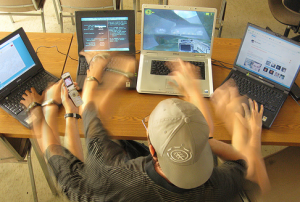Here is an interesting article from the blog of well known meditation teacher, Ian Gawler. He warns of the dangers to young people of using 2-3 communication devices at the same time.
Fortunately, he also offers some solutions.
Ian wrote a chapter on meditation for our book “How to stay Healthy, Active and Sharp in Retirement”.
Media multi-tasking – are our children losing their minds?
Seen any of this? Kids browsing the web while at the same time listening to music and watching TV. Ever found yourself reading an email while talking to someone on the phone? Welcome to the new world of media multi-tasking – an activity that recent research has associated with a smaller brain size.
We live in a busy world. So is doing more than one thing at a time helpful or harmful? This week, we go Out on a Limb once more and learn what modern research has to say about media multi-tasking, crucial implications it has especially for our youth, and then what ancient wisdom has to offer in this area.
Maybe this is a post to share with those you value who have children or get distracted easily.
From what we can observe, most of us these days seem to be getting caught up in more or less, but probably more, media multi-tasking. However, rather than a heightened new level of efficiency, many are concerned that this new found capacity represents a backward step, a deeper lapse into mindlessness, and that particularly our youth are suffering as a consequence.
A large body of research has already associated media multi-tasking with poorer performance on cognitive control tasks and higher levels of social and emotional difficulty. Now, to challenge us further, a recent study has shown that heavy media multi-tasking is associated with a smaller brain size.
It seems this form of multi-tasking, and the frequency with which it is practiced, leads to distraction, less capacity to hold concentration and generally higher levels of dissatisfaction along with an associated grumpy/angry mood.
This latest study examined the neural processes associated with media multi-tasking and found significant differences in brain structure. Using sophisticated Voxel-Based Morphometry analyses, the researchers found those with higher scores on a Media Multitasking Index (MMI) had smaller grey matter density in the anterior cingulate cortex.
The anterior cingulate cortex is an area of the brain that appears to play a role in a wide variety of crucial autonomic functions, such as regulating blood pressure and heart rate; but perhaps even more importantly is involved in functions such as decision making, impulse control, reward anticipation, empathy and even emotion in the general sense. Know anyone with problems in any of those areas?
Functional connectivity between this region of the brain and another, the precuneus, was negatively associated with MMI.
So just to be clear, these results do point to clear differences in the brains of those engaging in heavy media multitasking and those who do not. However, this study did not clarify whether the multi-tasking leads to a smaller brain, or those with smaller brains are more prone to mindless activity.
As they say, more research is needed. By contrast, what we do know from valid research is that mindfulness practice does “grow” the brain. For example, studies have shown that even 8 weeks of regular practise leads to measurable increases in brain size and density.
Certainly, the age old wisdom of “training the mind” by learning and practising mindfulness, meditation and other mind-body techniques makes good common sense. Happily, as these techniques become more and more mainstream, we may well have a realistic counter to some of the social and work practices that seem to becoming new norms.
What to do?
Do not despair too much if the kids are watching TV while talking to their friends and playing a video game. Just all the more reason to encourage them to counter any potential hazard by training their brains.
All of us understand the value of going to the gym or going for a run to train our bodies. If we sit around a lot, formal exercise makes all the more sense.
Experience tells me young people really relate to the notion of training their minds. If all the training their minds receive is in distracted, what hope is there? It is obvious a counter measure is needed.
Good news. Many schools are adopting mindfulness and meditation programs; many work places as well. As parents, we lead by example. If we are known to be meditating, and the kids observe us the better for it, they are likely to be further enthused.
You can read more of Ian Gawler’s wisdom on his site at www.gawlerblog.com
